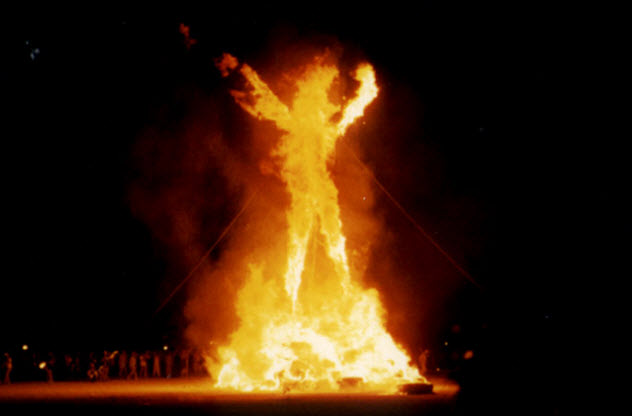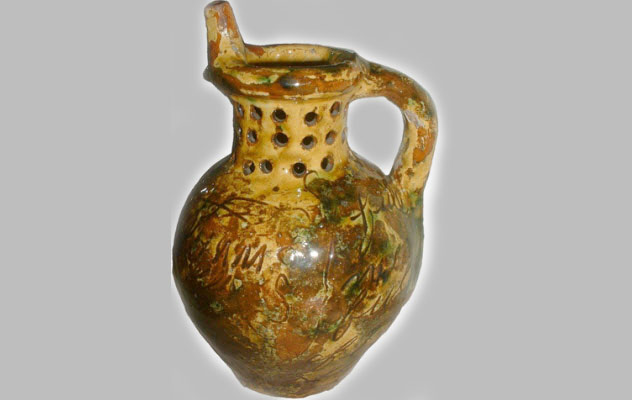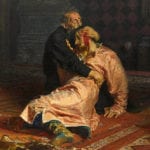 Our World
Our World  Our World
Our World  Pop Culture
Pop Culture 10 Incredible Female Comic Book Artists
 Crime
Crime 10 Terrifying Serial Killers from Centuries Ago
 Technology
Technology 10 Hilariously Over-Engineered Solutions to Simple Problems
 Miscellaneous
Miscellaneous 10 Ironic News Stories Straight out of an Alanis Morissette Song
 Politics
Politics 10 Lesser-Known Far-Right Groups of the 21st Century
 History
History Ten Revealing Facts about Daily Domestic Life in the Old West
 Weird Stuff
Weird Stuff 10 Everyday Products Surprisingly Made by Inmates
 Movies and TV
Movies and TV 10 Actors Dragged out of Retirement for One Key Role
 Creepy
Creepy 10 Lesser-Known Shapeshifter Legends from Around the World
 Our World
Our World 10 Science Facts That Will Change How You Look at the World
 Pop Culture
Pop Culture 10 Incredible Female Comic Book Artists
 Crime
Crime 10 Terrifying Serial Killers from Centuries Ago
Who's Behind Listverse?

Jamie Frater
Head Editor
Jamie founded Listverse due to an insatiable desire to share fascinating, obscure, and bizarre facts. He has been a guest speaker on numerous national radio and television stations and is a five time published author.
More About Us Technology
Technology 10 Hilariously Over-Engineered Solutions to Simple Problems
 Miscellaneous
Miscellaneous 10 Ironic News Stories Straight out of an Alanis Morissette Song
 Politics
Politics 10 Lesser-Known Far-Right Groups of the 21st Century
 History
History Ten Revealing Facts about Daily Domestic Life in the Old West
 Weird Stuff
Weird Stuff 10 Everyday Products Surprisingly Made by Inmates
 Movies and TV
Movies and TV 10 Actors Dragged out of Retirement for One Key Role
 Creepy
Creepy 10 Lesser-Known Shapeshifter Legends from Around the World
10 Times Our History Was Destroyed By Accidents And Stupidity
While we usually do our best to preserve our past, some of our world’s history was damaged or even lost to moments of unbelievable stupidity. Other times, accidents just happen. But sometimes, they happen to priceless relics.
10 The Neolithic Tomb Turned Into A Picnic Table
Spain is full of historical monuments. The ones over 100 years old must be registered with the government so that they can be preserved. Despite the laws protecting them, they are sometimes damaged. For example, builders in a Galician village once mistook a Neolithic tomb for a picnic table and “repaired it.”
The site had heritage status but had not been marked for some unknown reason. When workers saw the granite slabs, they thought the slabs were part of a park bench in need of repair. They poured concrete over the burial chamber and placed a new picnic table over it. The tomb is believed to be more than 6,000 years old from the area’s ancient Celtic settlers.
The mistake wasn’t realized until an environmental group complained to the local government. This set off a firestorm of finger-pointing to place the blame. The local mayor said that he simply hadn’t been informed that a site was located there, either by the local heritage organization or the environmental group.
The local Department of Culture, Education, and Universities countered by saying that archaeological research had taken place there earlier and that the council was aware of its existence. The regional government was also blamed before most people finally chalked up the error to a breakdown in communication due to the holidays.
9 Israel’s Burning Man Destroys A 150,000-Year-Old Site

Israel has its own version of Burning Man called Midburn. Like Burning Man, the festival prides itself on leaving “no trace” after the festivities are over. However, the Israeli Antiquities Authority (IAA) accused Midburners of leaving a heavy footprint when they torched an ancient Paleolithic and Epipaleolithic site.
The Midburners built the Temple of One, a star-shaped structure for contemplation, on a small hilltop that had been sporadically used by people as far back as 150,000 years ago. The site contained a number of ancient tools that were only identifiable by trained archaeologists.
The temple was torched at the end of the festival. But the problem was not the fire, it was the machinery used to construct the temple, which disturbed the artifacts’ distribution. There was no way to judge the age of anything after the site’s destruction.
Archaeologists claim that the festival organizers never got the permits required by the IAA, which led to the site being torched. Midburners claim that they got every other required permit but were never asked to get one from the IAA. They claim that they were unaware of the historical site and only informed of its existence after things were underway.
However, Yoram Haimi, the IAA’s district archaeologist, says that he toured the area during the event and asked the organizers to ensure that the temple would not be burned to the ground. He also says that he asked for the coals stoking the fire to be removed manually instead of with more heavy equipment, but neither request was fulfilled.
8 Greenpeace Destroys Part Of The Nazca Lines
In the Peruvian desert, Greenpeace activists hiked to the site of one of the Nazca lines to protest nonrenewable energy. Their plan was to unfurl a message in bright yellow letters—“Time for Change! The future is renewable”—beside one of the famous ancient images. Then they flew a drone over the area to capture their message on film.
However, the site is a restricted area that no one is allowed to enter because the environment is fragile and even a person’s footprints become permanent. The original drawings are actually shallow, and the land is covered with a thin layer of reddish sand. Even a small disturbance is readily visible. The activists walked to the site in a straight line, presumably to limit the damage they would cause, but walking in a straight line caused a new line to be formed in the sand.
After archaeologists became aware of Greenpeace’s stunt, they toured the area to check for damage. They could easily see where the activists had been, noting markings, overturned rocks, and the new line. The worst of it was that the outline of a giant “C” was still faintly visible.
When the Peruvian government called them out, Greenpeace argued that they did it “to honor the Nazca people.” They said they were surprised that their actions “resulted in some kind of moral offense.” Later, they issued a full apology.
The Peruvian government took legal action anyway. At first, Greenpeace withheld the names of those involved. But after an international outcry against them, they finally released the names. As the Peruvian government is seeking charges of “attacking archaeological monuments,” the perpetrators could face up to six years in prison.
The event also brought to light that a Japanese television crew visited the site in 2013. In response, the Peruvian government is pressing charges against the archaeologist who led them there. If their initial legal actions fail, the government has promised to take their complaints to the international courts.
7 The Little Boy Who Destroyed A 200-Year-Old Jug

While visiting a mansion that had been converted into a museum in Ipswich, Suffolk, a little boy accidentally knocked a 200-year-old “puzzle jug” off a low window ledge. So-called “puzzle jugs” were popular in the 18th and 19th centuries in homes and taverns. They had multiple spouts that made it challenging for “players” to drink from them without spilling. After this museum’s puzzle jug fell off the ledge, it shattered into 65 pieces.
The boy was about four or five years old and devastated that he’d broken the piece. Fortunately, the staff at Christchurch Mansion Museum realized that accidents happen and forgave him. Then they set about restoring the piece, which took about 65 hours. The jug is now on display in a new exhibit at the Ipswich Art Museum.
The museum never got the name of the boy or his family. The staff wants to make contact because they are concerned for the little boy who broke the jug. He was so upset after thinking that he destroyed it that they want to tell him that everything is fine now.
6 Priceless Objects Destroyed And Then Covered Up
In 2011, the Palace Museum in the Forbidden City destroyed a Song dynasty porcelain masterpiece when a researcher accidentally smashed it by incorrectly operating a testing instrument. But instead of owning up to the mistake, they covered it up.
Soon after, a blogger named “Longcan” wrote about the accident on his microblog, forcing the museum to come clean about the whole affair. But Longcan wasn’t finished. A short time later, he posted in his blog that the museum had covered up four other accidents in which important artifacts had been damaged.
He claimed that they destroyed a Ming dynasty talisman in 2006 and a Buddha statue in 2008. Another piece of artwork had supposedly been smashed when a museum staffer had been carrying it in his armpit. There is also a rumor that the Palace Museum bought five rare Song dynasty letters at auction during 1997 just to resell them at a different auction in 2005 for three times their purchase price.
If the claims are true, how did they all happen? A professor at the Minzu University of China blames the accidents on a lack of professional workers in Chinese museums. In 2008 and 2009, nearly 90 percent of museum employees in China did not have college degrees. Even the approximately 10 percent of staffers with college degrees had not studied museum-related subjects. The maintenance of a museum’s artifacts requires specialized knowledge, so those without professional training cannot take care of pieces properly.
5 The Broken Finger
A vacationing surgeon from America broke the number one rule of museums—do not touch the artwork—when he compared the size of his finger to that of a 600-year-old statue in an Italian museum. The result was an excellent example of why the rule is in place: The statue’s finger snapped off.
The tourist apologized and was described as “very disappointed,” but the Italian authorities were not taking it lightly. The surgeon was arrested in front of his family and taken into custody by police. Although they initially threatened to make him pay for restoration costs, the museum backed off, neither pressing charges nor making him reimburse their expenses.
The finger that the tourist broke was a plaster replacement, which may explain why it broke so easily at his touch. In pictures of it, you can see a metal rod sticking out of the hand from prior fixes. Fortunately, museum officials say that repairing the plaster finger will actually be quite simple.
4 The Statue Of The Two Hercules Ruined By A Selfie
The Statue of the Two Hercules sits in Cremona in northern Italy. It depicts the city’s emblem being held by two figures of Hercules, who was said to have founded the city. Before being relocated to its current site, the statue once adorned the city’s gates. It is over 300 years old and is seen as a symbol of the city. A large crown sat atop the city emblem until two tourists destroyed it.
The two men climbed the statue to take a selfie and then hung onto it with their full weight. A large piece of the crown broke off and shattered on the ground. The tourists’ nationalities are unknown, but this pair could be in hot water. Experts are not certain that the statue can be reconstructed.
Most damning, though, was that the tourists actually climbed the monument to take their selfie. This puts it beyond a mere “oops.” They could face criminal charges of vandalism. Given that another tourist was fined €20,000 for carving his initials into the Roman Colosseum, actually breaking a statue could carry a heavy fine.
3 King Tut’s Broken Beard
In 2014, visitors to the Egyptian Museum in Cairo noticed something peculiar about the burial mask of the famed King Tut: Its beard was glued on. The shoddy job was immediately noticed by everyone visiting the museum. “Beardgate” became a minor scandal because the museum did not reveal the mask had been damaged until photographs of the botched repair began circulating online.
The mask had been damaged accidentally when museum employees working on the lights bumped into the mask’s display case. The beard was knocked off, and the mask was scratched. According to the museum, repairs were rushed because the museum staff panicked. The curator used the wrong type of adhesive. Instead of using a glue that dried slowly so that the beard could be adjusted throughout the day, the staff used a glue that dried quickly and left the beard obviously damaged.
Despite the debacle causing scandal and bringing heat on the museum for only coming clean once the problem was made public, Egyptian officials are defending the museum. They say that the job was done correctly. Experts agree that the “restoration” was crude but say the damage done to the mask was exaggerated. The Egyptian Museum announced that the mask will be repaired again but more “sensitively” this time.
2 Ghost Hunters Burn Down A Haunted Plantation
Built in the 1850s, the LeBeau Plantation in St. Bernard, Louisiana, had a long history of ghostly sightings. Its reputation caught the attention of seven “ghost hunters,” who trespassed on the property to look for paranormal activity.
When it became clear that the plantation wasn’t giving up any of its supernatural secrets, the group decided to kill time by drinking alcohol and smoking marijuana. After that, things got even crazier. Frustrated by the lack of any ghosts in the building, they set fire to the plantation. Whether they were angry, hoping to draw out ghosts, or just wasted, only the building’s four chimneys were left standing by the time the local fire department brought the blaze under control.
The perpetrators ranged in age from 17 to 31. All were arrested and charged with a range of crimes: arson, simple burglary, accessory to arson and burglary, criminal trespassing, and criminal damage of $50,000. The plantation was the site of a local fall festival and was being considered for renovation because it had once served as a hotel. Unfortunately, the group of trespassing ghost hunters left nothing to renovate.
1 US-Led Occupation Forces Damage Ancient Babylon
The war that toppled the regime of Saddam Hussein has had a long list of consequences for Iraq and the world at large, but one that went mostly unnoticed was the damage to the country’s history. Iraq is the location of ancient Babylon, regarded as one of the world’s most important historical sites. It suffered extensive damage during the US-led occupation.
During the 2003 invasion, US Marines used the ruins of Babylon as a base to protect the site from looting, but Iraqi and foreign archaeologists say that their presence caused damage itself. The numerous military vehicles damaged the prehistoric brickwork, which broke under the heavy weight of the vehicles. The vibrations of helicopters also caused the roof of one building to collapse. Gravel brought in to create parking areas contaminated archaeological deposits irreparably. Precious stonework was also used to fill sandbags.
After hearing the complaints of archaeologists, a senior US military officer said that he was willing to apologize for the damage. All earthmoving was halted. But the officer also stressed that without the US presence in the ancient ruins, the damage would have been far worse. Occupying the site, he claimed, was better than leaving it to looters in the chaos of postwar Iraq. Either way, it remains a tragedy that any part of our history was lost to war.
Nathan keeps a Japan blog where he writes about the sights, expat life, and finds Japanese culture in everyday items. You can also find him on Facebook and Twitter.








